The great beauty of travelling across Aotearoa New Zealand’s North Island is the sheer diversity of experiences on offer. The Island is home to many of the country’s most cosmopolitan cities, but equally its regional centres are packed with historical and cultural attractions. And then there’s the incredible natural beauty to enjoy, with wondrous landscapes in virtually every direction. If you’re first and foremost a nature lover, here are eight amazing landscapes to tick off. Book your accommodation with Choice Hotels and get ready for the adventure you’ll remember for a lifetime!
1. Tāne Mahuta
From Whangarei: 1.45 hours’ drive via Dargaville, 2.10 hours via Kaikohe
At an estimated 2,000 years old, Tāne Mahuta is the largest known kauri in New Zealand. You cannot spend time in Northland without seeing this forest giant for yourself. The kauri is considered a taonga (treasure) by Māori who see the health of these trees as a sign of the health of the whole forest. Unfortunately, the trees are at risk from kauri dieback disease, which threatens their existence despite all efforts being made to save them. Tāne Mahuta can be found in the Waipoua Forest between Hokianga Harbour and Dargaville. There’s clear signposting and a carpark located across the road from the forest entrance. As you enter the forest you will go through a large wash station where you are required to scrub and disinfect your footwear. From there it’s a short five-minute walk to Tāne Mahuta. And when you do finally see this tree, you’ll be struck by its magnificence. Visiting Tāne Mahuta can make a great round trip from Whangarei when you can include other regional highlights like The Kauri Museum, Dargaville Museum and Ngawha Hot Springs.
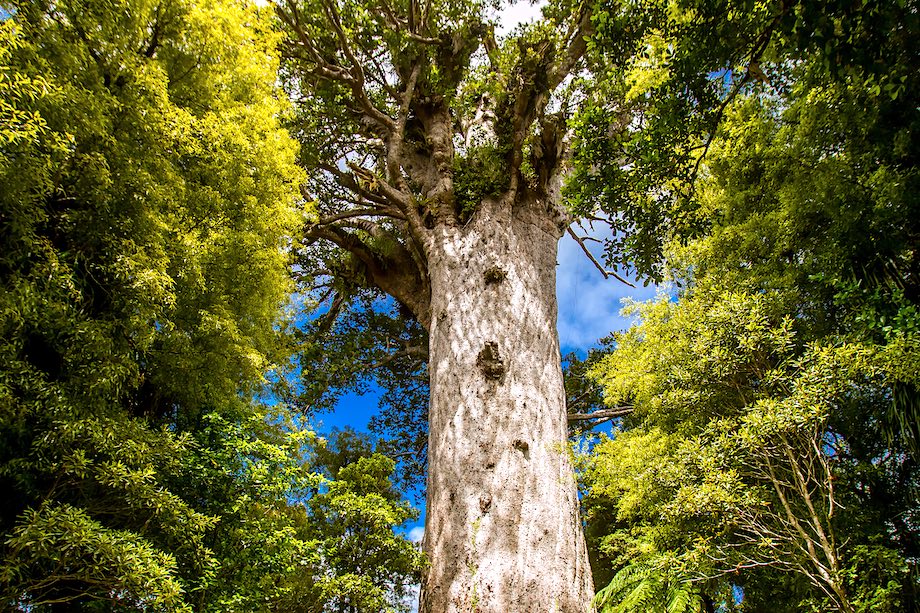
2. Poor Knights Islands Marine Reserve
From Tutukaka: 35 minutes by boat
Located off Northland’s east coast, the Poor Knights Islands are recognised as one of the top diving locations in the world. The waters surrounding the islands are protected as a marine reserve, which allows sea life to thrive. Exploring the sea caves, cliffs and kelp forests is an amazing experience, and visiting the marine reserve is a very popular summer activity. However, you won’t be allowed onto the islands themselves, as they’re home to many rare and endangered wildlife and plant species. There are several tour operators based in Tutukaka that offer marine experiences to suit all ages and interests. From January through to May you can expect the warmest waters, at 20-23 degrees Celsius, with visibility up to 20 metres.
You May Be Interested In: Walk This Way: Hiking in New Zealand’s North Island
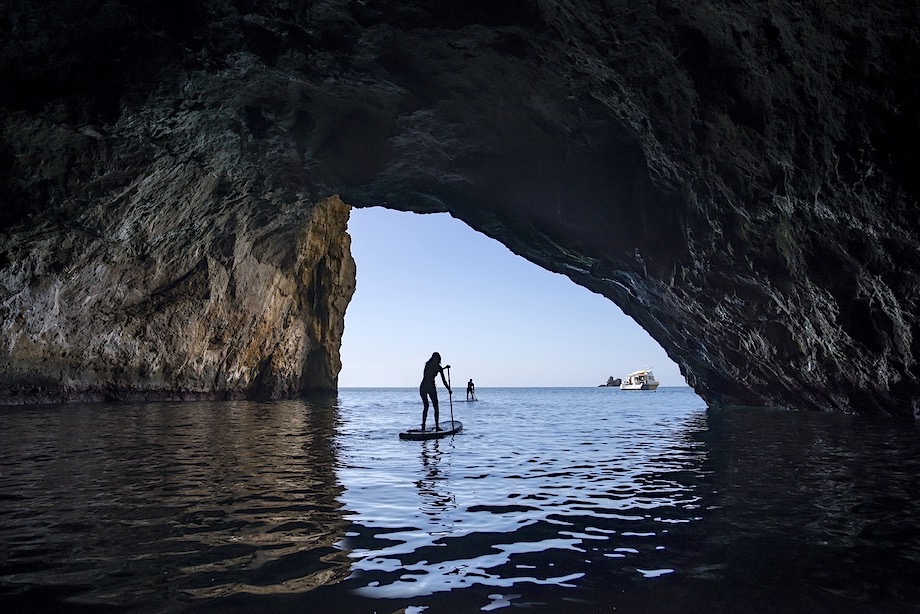
3. Rangitoto Island
From Downtown Auckland: 25 minutes by ferry
The youngest volcano in all of Aotearoa New Zealand, Rangitoto is a mere 600 years old. The island was given its name by those who witnessed its eruptive formation and translates to ‘bleeding skies’. Today thousands of people visit the island to enjoy the walks and views it offers. The island is home to the world’s largest pōhutukawa (aka New Zealand Christmas tree/bush) forest, which blooms from late November through to Christmas. It’s an impressive sight. Getting to the island is easy with Fullers 360 from downtown Auckland or Devonport. There are several ferry trips each day, so you can plan to spend from a couple of hours to most of the day on the island.
Discover More: Couples Escape to the North Island, New Zealand
The most popular walk on the island is to the summit via the lava caves. Give yourself an hour and a half to reach both of these destinations, and a minimum of four hours on the island. For a longer return trip to the wharf, you can head down to the lighthouse and take the coastal track. As you near the wharf, you’ll come across old boathouses and baches which add a little character to the coastline. One of these baches may be open to the public for viewing.
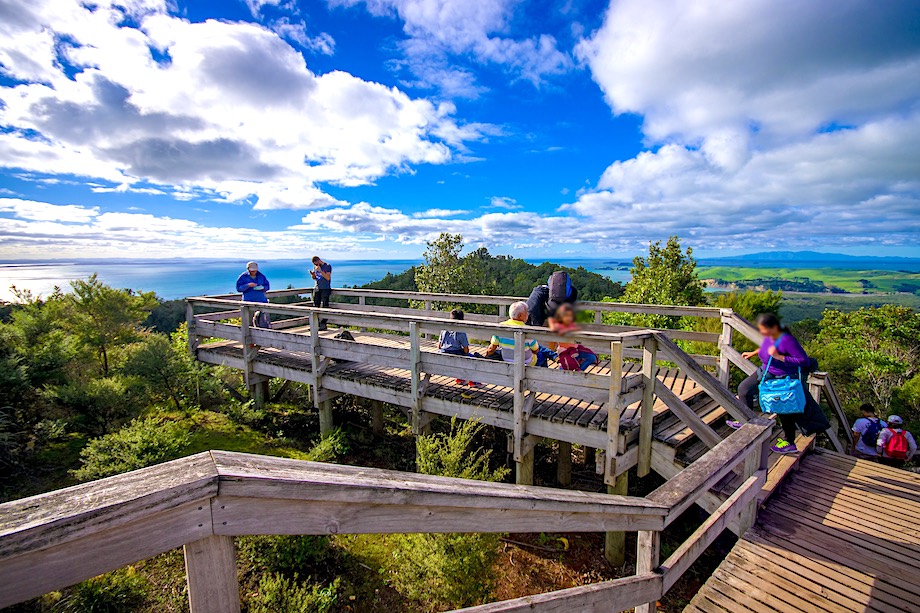
4. Waitomo Caves
From Auckland: 2.10 hours’ drive, or from Taupō: 1.50 hours
The Waitomo Caves are one of the most popular tourist attractions in New Zealand, and for good reason. This magical underground world offers an experience like no other. Glow worms are the main attraction and can be found in two of the three caves that are accessible by foot – the Glow Worm Caves and the Ruakuri Cave (which is also accessible by wheelchair). The Aranui Cave doesn’t have glow worms, but is popular for its impressive stalactites and stalagmites. For the adrenaline junkie, a black water rafting experience is also on offer and is loads of fun. The caves are rich in history, geology and biology, and a guided tour will give you a fascinating overview of all three. All experiences should be prebooked to ensure there’s space on a tour the day you visit. There are some great deals available if you choose to combine experiences.
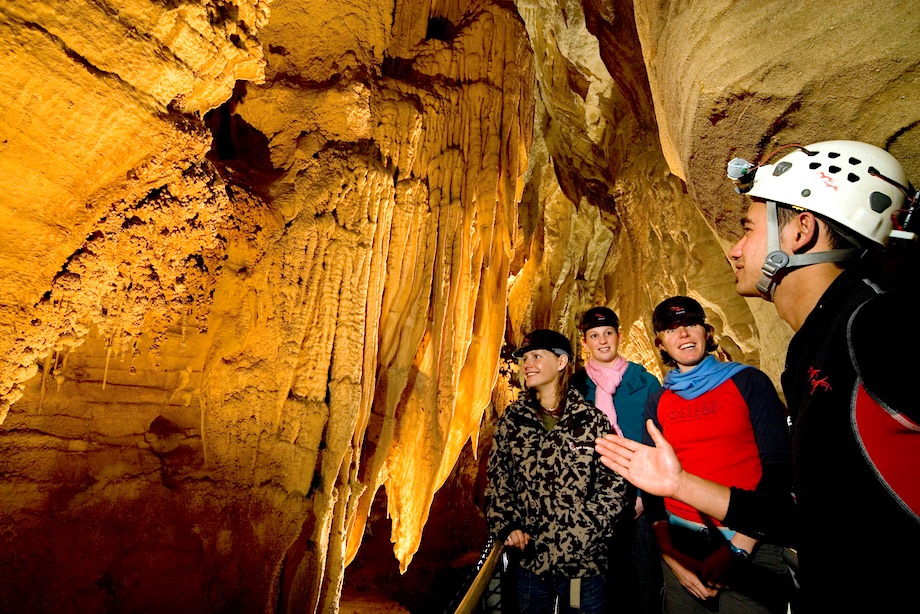
5. Waimangu Volcanic Valley
From Taupō: 45 minutes’ drive
What makes Waimangu Volcanic Valley special is that it’s the world’s youngest geothermal system. It was created by the 1886 eruption of Mount Tarawera – well-known for having buried the world-famous pink and white terraces that were a prominent feature on the shores of Lake Rotomahana. Once considered the eighth wonder of the world, the terraces were the largest silica sinter deposits on earth. Today you can walk through the valley and enjoy the geothermal sights, including mud pools, steaming vents and hot pools. The Frying Pan Lake is one of the largest hot water springs in the world and the beautiful Inferno Crater Lake rises and falls as it heats and cools.
At the bottom of the valley, there’s an option to do a 45-minute boat cruise on Lake Rotomahana with full commentary from the captain. And if you don’t fancy walking back up the hill, catch one of the regular buses that takes visitors to and from the cafe and gift shop.
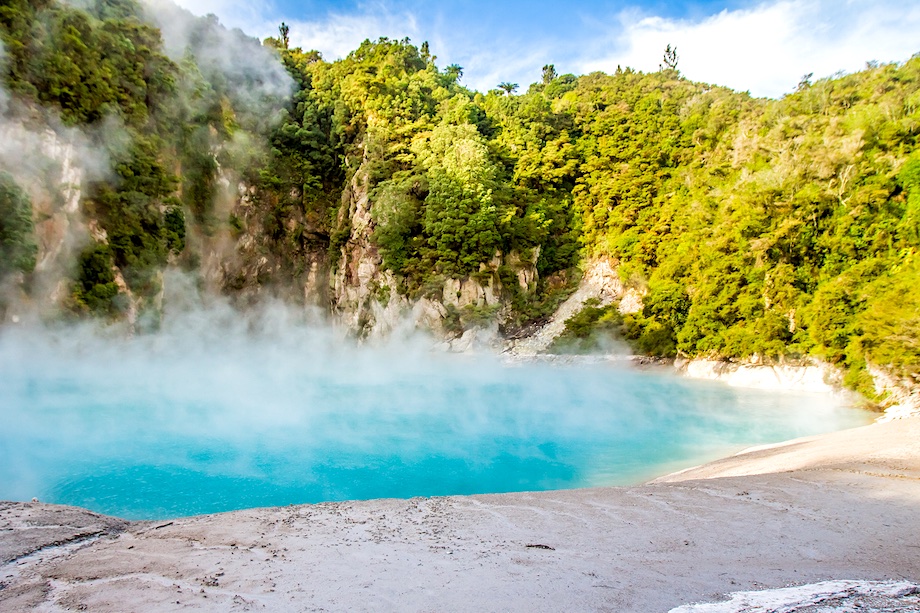
6. Tongariro Alpine Crossing
From Taupō: 1 hour’s drive
Renowned as the best one day walk in New Zealand, the Tongariro Alpine Crossing is a ‘must-do’ for any able hiker. The track is located in the Tongariro National Park – New Zealand’s oldest national park, and home to three very distinct volcanoes (Tongariro, Ngauruhoe and Ruapehu). The national park has dual world heritage status, which recognises its importance both to Māori culture and for its incredible natural features. Starting at the Mangatepopo carpark, this 19.4-kilometre one-way track requires a reasonable level of fitness. As it is an alpine hike, the conditions must be taken seriously and those attempting it must be prepared. Remember that the weather conditions can change rapidly, and a call to the Whakapapa Visitor Information Centre is the best way to get all the information you need when planning to doing the walk. The best time of the year to go unguided is from November through to May when there is likely to be little or no snow. Unless you are an experienced alpine hiker, you would be advised to book a guided tour when there is snow. There are parking restrictions in operation from October through to April (a maximum of four hours), but it’s best at any time of year to arrange drop-off and pick up. There are several shuttle operators in the area that can help with transportation.
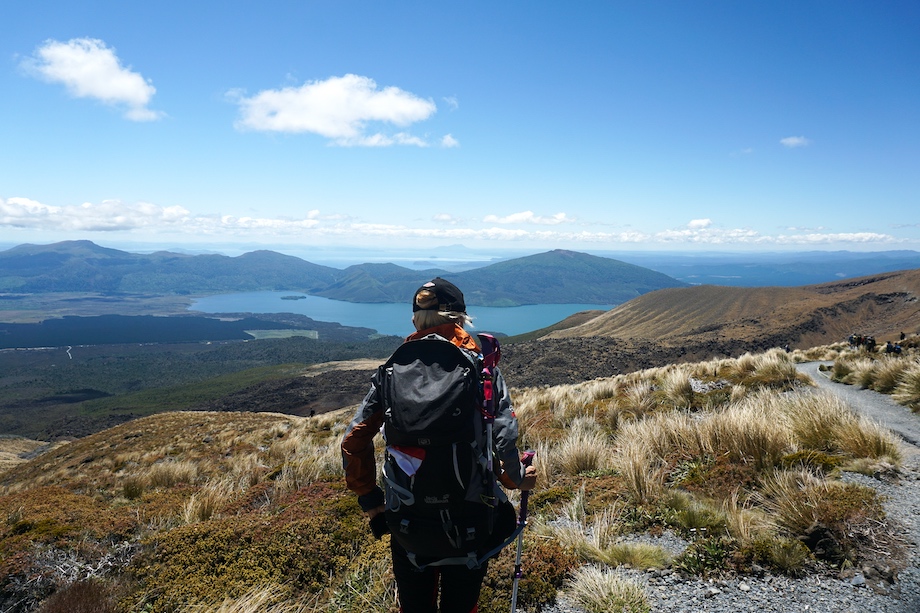
7. Whanganui River
From Palmerston North: 50 minutes’ drive
The Whanganui River is the longest navigable river in all of Aotearoa New Zealand. Rising on magnificent Mount Tongariro, it weaves its way towards Taumarunui and through Whanganui National Park, before finally reaching Whanganui and the Tasman Sea. The river is rich in resources and history, with Māori arriving around 800 years ago and settling along its banks. Many traditional marae remain, as do the descendants of those original settlers. When Europeans arrived, they also saw the richness of the river and surrounding lands, and began farming in the area.
This river is a magnet for outdoor enthusiasts and offers many fantastic experiences, including canoeing, biking, hiking and jet boating. A trip to the Bridge to Nowhere is a popular activity for those visiting the region. There are two ways to get there from Whanganui: by boat and a short walk, or by tramping/biking 35 to 40 kilometres (one way). A road trip from Whanganui along the Whanganui River Road is also a great day out, with plenty of points of interest to see on the way. Despite not being a walk, a journey by canoe along the Whanganui River is included on the list of New Zealand’s Great Walks. The five-day trip starts in Taumarunui and finishes in Pipiriki. A three-day option is also available.

8. Putangirua Pinnacles
From Wellington: 1.40 hours’ drive
The Putangirua Pinnacles are some of the most incredible rock formations you will find anywhere in New Zealand. Getting there from Wellington is quite a drive, but anyone who has been will tell you it’s absolutely worth it. The pinnacles are made up of ancient layers of gravel that were concreted together over time, then slowly exposed to the elements over tens of thousands of years. They are so unusual that director Peter Jackson featured this location in the third movie of The Lord of the Rings trilogy. Getting to the pinnacles requires some walking, and there are a few options to choose from. But they all start from Putangirua Pinnacles Scenic Reserve in the Aorangi Forest Park. Easy walking tracks lead to the bottom of the pinnacles, and you can also head up to a lookout (which does involve a decent ascent). Following any of the tracks should bring the pinnacles into sight within 45-or-so minutes, but doing a full loop can take three to four hours. Wear sturdy footwear, pack a hat and sunscreen, and bring some food and water so you can make a day of seeing this incredible natural wonder.
Need a place to stay? Choice Hotels has you well and truly covered across the North Island with a superb range of accommodation options to suit every budget. Search online and book direct for a Lowest Price Guarantee.

Related: Top 4 places to see in Rotorua
About the writer
Hailing from Aotearoa New Zealand, Karllie Clifton is an avid midlife traveller and blogger who loves an adventure. In the past few years alone, Karllie has visited over twenty countries and ticked off more than 50 cities across three continents. She loves the great outdoors – especially hiking and anything to do with the ocean.


